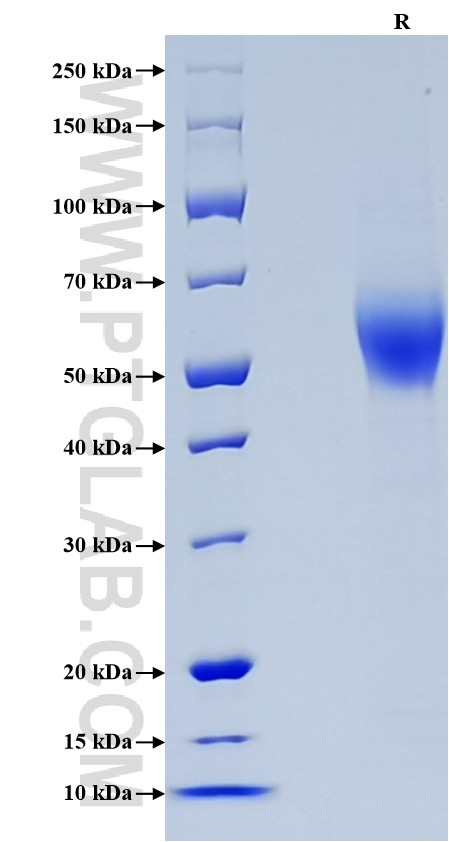Recombinant Human CD155/PVR protein (His Tag)
种属
Human
纯度
>90 %, SDS-PAGE
标签
His Tag
生物活性
未测试
验证数据展示
产品信息
| 纯度 | >90 %, SDS-PAGE |
| 内毒素 | <0.1 EU/μg protein, LAL method |
| 生物活性 |
Not tested |
| 来源 | HEK293-derived Human CD155 protein Trp21-Asn343 (Accession# NP_006496) with a His tag at the C-terminus. |
| 基因ID | 5817 |
| 蛋白编号 | NP_006496 |
| 预测分子量 | 36.2 kDa |
| SDS-PAGE | 48-68 kDa, reducing (R) conditions |
| 组分 | Lyophilized from 0.22 μm filtered solution in PBS, pH 7.4. Normally 5% trehalose and 5% mannitol are added as protectants before lyophilization. |
| 复溶 | Briefly centrifuge the tube before opening. Reconstitute at 0.1-0.5 mg/mL in sterile water. |
| 储存条件 |
It is recommended that the protein be aliquoted for optimal storage. Avoid repeated freeze-thaw cycles.
|
| 运输条件 | The product is shipped at ambient temperature. Upon receipt, store it immediately at the recommended temperature. |
背景信息
CD155, also known as PVR, is a type I transmembrane glycoprotein in the immunoglobulin superfamily. It contains three extracellular immunoglobulin-like domains, D1-D3, of which D1 is recognized by the virus. Mature human CD155 consists of a 323 amino acid extracellular domain with one N-terminal V-type and two C2-type Ig-like domains, a 24 amino acid transmembrane segment, and a 50 amino acid cytoplasmic tail. CD155 is thought to play a role in adhesion by interaction with the ECM component vitronectin as well as a role in NK killing of tumor cells. CD155 binds to two receptors of NK cells, CD96 and CD226, and accumulates at cell-cell contact sites, leading to the formation of mature immune synapses between NK cells and target cells. CD155 serves as the entry receptor for poliovirus and thereby mediates human susceptibility to poliovirus infection.
参考文献:
1.Zhang, Ping et al. Proceedings of the National Academy of Sciences of the United States of America vol. 105,47 (2008): 18284-9. 2.Paolini, Rossella, and Rosa Molfetta. International journal of molecular sciences vol. 24,16 (2023): 12958. 3.Lupo, Kyle B, and Sandro Matosevic. Journal of hematology & oncology vol. 13,1 (2020): 76. 4.Solecki, David J et al. The Journal of biological chemistry vol. 277,28 (2002): 25697-702.


